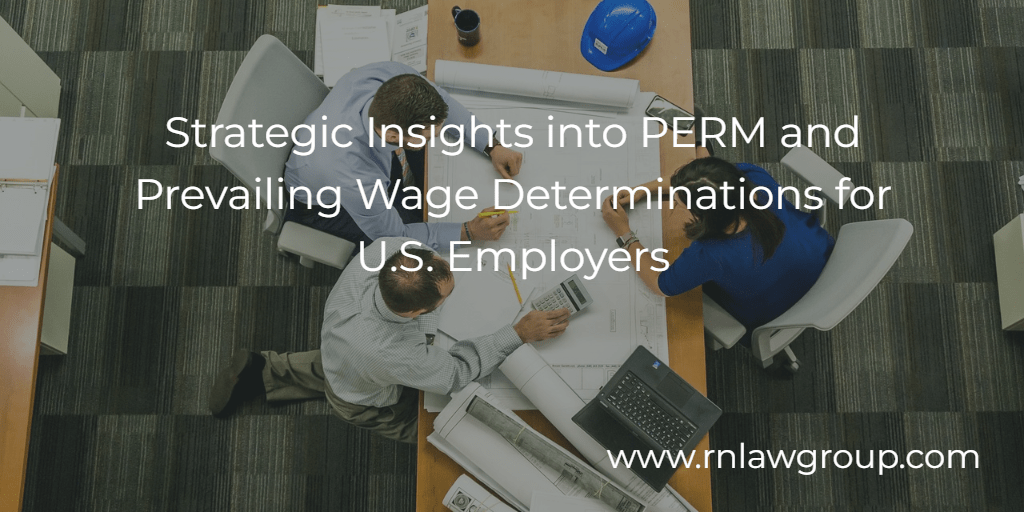
Strategic Insights into PERM and Prevailing Wage Determinations for U.S. Employers
When a U.S. employer decides to sponsor a foreign worker for a green card, the first step the U.S. employer must complete is obtaining an approved Labor Certification, also commonly known as PERM. This intricate process entails navigating through various meticulous and time-consuming procedures before the U.S. Department of Labor grants certification to the PERM application.
At its core, the primary objective of the PERM process is to test the U.S. labor market to demonstrate that the employment of the foreign worker under consideration will not displace U.S. workers. The ultimate aim is to affirm that there are no “able, willing, qualified, and available” U.S. workers to fill the position which the foreign worker will ultimately be sponsored for.
While the PERM process is the first step in obtaining a green card for a foreign worker, within the PERM process itself, there are numerous steps that must be taken. One of these steps is obtaining a Prevailing Wage Determination, also known as a PWD.
WHAT IS THE PREVAILING WAGE DETERMINATION?
Upon finalization of the job details and description of the sponsored position, a Prevailing Wage Request is submitted to the Department of Labor. As delineated by DOL, the prevailing wage is the average wage paid to employees similarly employed in the area of intended employment. It is important to note the issued prevailing wage is the wage the U.S. employer will be required to offer, as DOL believes offering at least the prevailing wage amount ensures wages and working conditions of other U.S. workers will not be adversely affected.
THE PWD AND THE BEGINNING OF RECRUITMENT
Currently at the time of this writing, we are seeing Prevailing Wage Determinations take 5 to 6 months to be issued. PERM regulations provide U.S. employers two options regarding the validity of a PWD. PWDs are issued with a limited validity period within which. U.S. employers must either file the PERM application or begin recruitment. In simpler terms, the U.S. employer has the option of beginning recruitment before the PWD is issued or after the PWD is issued. If recruitment begins before the PWD is issued, the PERM application cannot be filed until the PWD is received and must be filed while the PWD is still valid. If recruitment begins after the PWD is issued, the PERM application must be filed within 180 days.
Both scenarios offer distinct advantages and drawbacks.
ADVANTAGES OF ADVERTISING WHILE THE PWD IS PENDING
Obtaining a Labor Certification is a time consuming and complex process. As previously stated, prevailing wage determinations are currently taking around 5 to 6 months to be issued. The shortest amount of time the recruitment process can be completed is 60 days due to the requirement of a 30 day posting with the State Workforce Agency and the 30 day mandatory quiet period that occurs after. Beginning the advertisements before the PWD is issued can speed up the process by 60 days. Depending on how quickly the PERM application needs to be filed, these 60 days can make a huge difference.
ADVANTAGES OF BEGINNING ADVERTISING AFTER THE PWD IS ISSUED.
While saving 60 days can be seen as a huge boon when taking into consideration the length of the overall PERM process, there are many advantages to waiting until the PWD is issued to begin the recruitment stage.
If for some reason the employer does not wish to continue the green card process for a foreign worker once the PWD has been issued, no resources would have been spent on advertising. These resources include time and money.
Timing issues are another reason why a U.S. employer may want to wait until the PWD has been issued to begin advertising. As stated previously, if recruitment is started before the PWD has been issued, the PERM application must be filed after the PWD has been issued and during the PWD’s validity period. PWDs are valid for at least 90 days, sometimes longer. However, if for some reason all the recruitment efforts cannot be completed during the PWD’s validity period, the PERM application cannot be filed. If the PWD is no longer valid, the U.S. employer will need to start the process again and file a new prevailing wage request with DOL. When all recruitment is started after issuance, the PWD will remain usable after its expiration date as long as at least one recruitment effort began before its expiration date.
If the U.S. employer believes the PWD was issued incorrectly and needs to be revised in some manner, the employer may want to submit a Request for Reconsideration. Submitting a Request for Reconsideration will cause the issuance of the PWD to take longer. Recruitment efforts (i.e., the ads placed) are only valid for a limited amount of time – 180 days. If the recruitment efforts are started too early and expire before the PWD has been issued, all the recruitment efforts will need to be redone.
Additionally, waiting until the PWD has been issued will help ensure accuracy. There is a bit of uncertainty built into the PWD process, and many times DOL will issue a different (i.e., higher) wage than the U.S. employer was counting on. A new challenge in today’s recruitment efforts is state and local equal pay transparency (EPT) laws. These new EPT laws require employers state the minimum and maximum wage offered for a position in all job postings. If the prevailing wage determination comes back higher than originally anticipated, any ads – including the Notice of Filing – which contain the wage will have to be redone. While originally hoping to save time, having to redo some or even all of the advertisements can ultimately cause even more delay and expenditure.
CONCLUSION
The process of obtaining a green card for a foreign worker through the PERM process involves several intricate steps, with the Prevailing Wage Determination (PWD) playing a crucial role. The decision of when to begin advertising for the position can significantly impact the efficiency and cost-effectiveness of the entire process.
Starting the recruitment process before the PWD is issued can expedite the overall timeline by approximately 60 days, potentially saving valuable time, especially in cases where prompt filing is necessary. However, there are risks involved, such as the possibility of resources being wasted if the employer decides not to proceed with the green card process after the PWD is issued or if there are timing issues that prevent the timely filing of the PERM application.
On the other hand, waiting until after the PWD is issued before beginning recruitment offers advantages such as avoiding resource wastage in case of changes in plans, ensuring compliance with validity periods, and allowing for accuracy in advertising efforts. Additionally, waiting until after the PWD is issued provides the opportunity to address any discrepancies or issues with the prevailing wage determination before proceeding with recruitment efforts, potentially averting delays and additional expenses associated with redoing advertisements.
Ultimately, the decision of when to commence recruitment hinges on various factors, including the urgency of filing the PERM application, risk tolerance, and the need for accuracy and compliance. By working with an experienced attorney, U.S. employers can carefully weigh the advantages and disadvantages of each approach, and employers can navigate the PERM process effectively to secure the desired outcome for both the foreign worker and the sponsoring organization.
Register now for our UPCOMING WEBINAR – Mastering PERM Recruitment: The Heart of the PERM Labor Certification Process where we delve deeper into the intricacies of PERM recruitment and provide valuable insights to enhance recruitment strategies.
For over 25 years, Reddy Neumann Brown PC. has focused solely on U.S. employment-based immigration, and works with employers to establish best practices when navigating the PERM labor certification process. If you are in need of a U.S. work visa or permanent residency, speak with one of our immigration lawyers. Please contact us online, call our Houston business immigration office directly at 713-953-7787 or schedule a consultation.
By: Jessica Palarca
Jessica Palarca is an attorney in Reddy Neumann Brown’s PERM Labor Certification Department where she assists clients in the beginning stages of the green card process.

